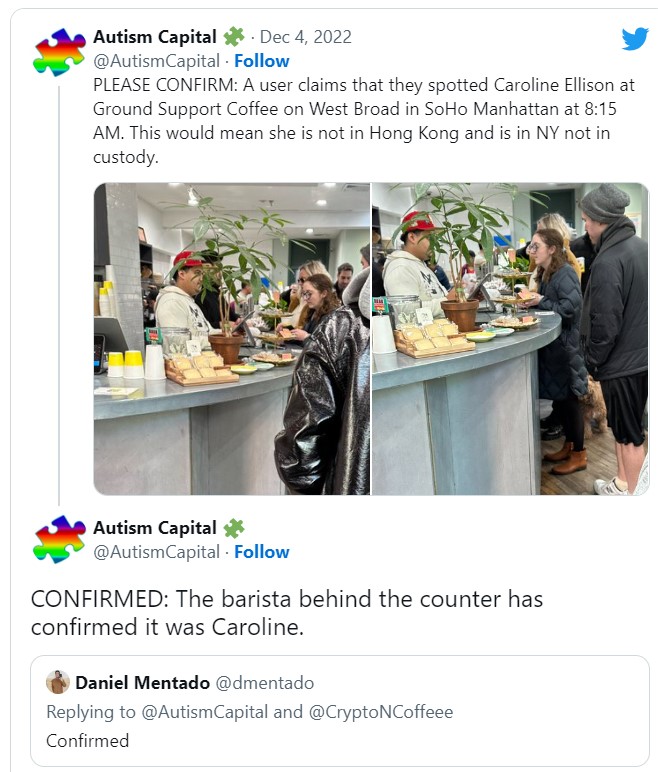Former Alameda Research CEO to Backstab SBF?
Rumors about Caroline Ellison moving to Dubai have been spreading, but will the latter be able to flee there? Mission impossible.

Former Alameda Research CEO Caroline Ellison was spotted on Monday morning at the Ground Support Coffee on West Broad in SoHo Manhattan just blocks away from FBI offices, disputing the rumors that she’s in Hong Kong.
Autism Capital — an anonymous Twitter account that has been a go-to source for rumors (some true, some not) about everything related to Bankman-Fried — posted two pictures that appeared to show Ellison at a coffee shop in Manhattan. The sighting hasn’t been confirmed by proper reporting, but the manager of the store then said on his personal account that it was her.

This is notable because Ellison is supposed to be hiding somewhere in Dubai or Hong Kong. Her return to the States without being escorted by federal agents means the following: she’s in town to negotiate with investigators and backstab SBF much?
However, the sure thing is that she won’t ever set foot in Dubai, as the country considers itself to be one of the cornerstones of the Blockchain and crypto space.
With VARA and ADGM working non-stop to regulate the space and protect the Emirate’s reputation worldwide, the chances of Ellison moving are extremely slim.
The whole story started with a media report claiming FTX’s sister hedge fund, Alameda Research, is insolvent and expected to suffer as much as FTX. In fact, most of its assets are tied to FTT and other tokens to Bankman-Fried.
Ellison tried to refute the report, saying it is a balance sheet just “for a subset of our corporate entities” and, therefore, doesn’t reflect the entirety of the company.
However, according to the deep dive, after FTX started crashing, Ellison disclosed the cause of the collapse to Alameda staff. She apologized for disappointing the group and claimed that in recent months, the company had taken out loans and utilized the proceeds to fund venture capital investments, among other things.
Ellison further explained that around the time the crypto market crashed this spring, lenders moved to recall those loans, according to a person familiar with the meeting. However, the funds that Alameda had spent were no longer readily available, so the company made the payments using FTX customer funds.
She said that, in addition to her and Bankman-Fried, two other people were aware of the arrangement: Director of Engineering Nishad Singh, and CTO Gary Wang.
It is important to note that Bankman-Fried and Ellison were at times romantically involved–which the FTX founder confirmed although they are not in a relationship anymore. In addition to that, the road taken by Ellison seems to be a smarter, as Bankman-Fried’s media appearances, against the advise of his lawyers, seem to be doing more harm than good for him.
This being said, Ellison would be a top priority for any prosecutor trying to indict Bankman-Fried. She has already talked about how he directed investments at Alameda — and, in at least one case, has talked about how he “convinced” her that Alameda should invest in one of his other companies.
This contradicts the general line that SBF gives nowadays: he wasn’t really all that involved in what Alameda was up to. Nevertheless, if such stories are already starting to show in Bankman-Fried’s own story, the Justice Department is going do its best to keep finding more.
Speak now or face RICO
According to CoinGeek, if Ellison has indeed decided to cooperate with the authorities, then it’s the best move she’s made since deleting her polyamory Tumblr blog.
Why? Because Ellison has no doubt realized the role she has played in a pattern of illegal activity, which almost certainly brings her (and any other FTX group employee doing the organization’s dirty work) within the ambit of the U.S. RICO (Racketeer Influenced and Corrupt Organisations) Act.
Originally used by law enforcement to pursue large-scale criminal organizations like the Mafia, the RICO Act applies to any criminal organization engaging in a pattern of ‘racketeering activity,’ which is defined to include money laundering and fraud.
Under RICO, any corporate partitioning designed to make the entities look distinct on paper will be useless: it is the practical reality that matters in assessing a criminal enterprise, as pointed out by the U.S.
The closely knit web of FTX companies qualifies based on what we already know about FTX’s use of client funds. In fact, Alameda almost certainly already settled a civil suit in which it was being accused of running a RICO enterprise in 2020.
Individual employees can be prosecuted under RICO, and each individual count of racketeering carries a maximum penalty of 20 years in prison. Also, RICO action can be taken on both a criminal and civil basis, either by law enforcement or by private citizens. Anyone who has been injured by a RICO violation can bring a civil suit for compensatory and damages.
With that kind of pressure on FTX’s executives and employees, it’s a wonder that Ellison has waited this long to flip on Bankman-Fried. It is also surprising that former FTX employees have not reached out yet to the FBI. Or they did?
Regardless, will Ellison be willing to testify before the Congress in Bankman-Fried’s absence? No one knows, but something is cooking for sure.
The Analysis
As obvious by now, Alameda Research could be replaced by ‘SBF’s personal account’. Therefore, when Alameda borrows FTX customer money, that means Sam is borrowing customer money.
In fact, knowing that Alameda had no clients, one can say that it was 100% owned by Sam and a few friends, but Alameda had liquidity issues, so it took a loan from FTX. To paper the loan, it posted collateral to FTX, which was ‘pretend money’. SBF, however, has been claiming that Alameda wasn’t run by him, giving him the power to deny that he knew about the company’s issues.
According to Compound248, Alameda still needed the money to cover its margin loans from 3rd parties (like Gemini or Binance…maybe FTX?). Therefore, it used FTX client assets, and to pretend that it was okay, FTX needed to hold collateral from Alameda as security against the loan in case the latter doesn’t repay.
Together, FTX & Alameda (Sam & Sam) developed a few tokens, the most relevant being $FTT and $SRM, which both FTX & Alameda received huge grants for. Nevertheless, it is important to note that only a tiny portion of $FTT / $SRM traded.
Alameda was the largest trader; if you own 95% of something and then manipulate the price of the other 5%, you can make your 95% look really valuable – just keep the price of that 5% up and look how valuable your 95% becomes!
Of course, FTT and SRM were used as collateral for those margin loans, and it doesn’t appear that FTX required a substantial haircut on the $FTT that Alameda (Sam) posted. This lead to the “borrowing of the $9-$10 billion from FTX”. That money was, almost by definition, FTX customer money.
Sam may argue this is just how banks and brokerages work: they take deposits, they lend them out based on credit judgments to earn a spread, and – as long as depositors don’t ask for deposits back in huge amounts – all is perfectly fine. However, it did not end well for him, as this wasn’t the case.
As previously mentioned, Alameda & FTX invented intrinsically worthless tokens, keeping almost all of it for themselves. They traded a tiny percentage, controlling the trading price. This manipulated the implied value of all of Sam’s $FTT tokens then used the resultant implied token value as collateral to “borrow” customer funds from FTX.
The bogus collateral was one giant identical (non-diversified) risk, funding related-party transactions, and FTX lied about doing it via misleading Terms of Service.
This horror movie could have lasted longer, except that Sam made one terrible mistake. At FTX’s founding, Binance / CZ was a seed investor. As FTX evolved into a full-fledged Binance competitor, FTX reacquired Binance’s seed stake using a mix of payments. One of those was FTT.
Amazingly, the only big part of $FTT’s float that Sam did not control was controlled by his rival: CZ. When it became public that Alameda was relying heavily on $FTT as collateral, CZ understood his $FTT wasn’t worth the magic paper it wasn’t written on.
CZ held the keys to killing his loudest, most annoying competitor and he used them.
Good for CZ – hopefully Binance itself is sound.
None knows what is next or where the $10B went. Perhaps Alameda lost it fair and square, perhaps it was stolen. Only time and justice will tell.





